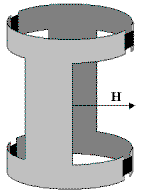10B enriched BSH molecule, NMR and BNCT
Our Work: self-made probe


The Alderman & Grant
A&G finds its prototype in STR (slotted tube resonator) ideated to remedy the lack of quality of usual resonators at higher frequencies than 100MHz (Schneider & Dullenkopf 1977a). STR is obtained cutting a conduting tube (making it than a trasmission line called STL: slotted tube line), cortocircuiting it at a lenght l/4 and screening it (here l is the interested wavelenght corresponding to a c/l frequency). In cutting there is an optimum opening window empirically determined as 50°. There is an optimum distance of the screen too, it is 2 time de diameter of STR. One problem of this structure is its big dimension at low frequencies (at 100MHz its lenght has to be 75cm).
A&G (Alderman & Grant 1978) make use of distribuited capacities to allow the use of smaller dimensions without lack in field homogeneity (an important good quality of STR). An importan rule is played by guard rings too. They confine into themselfs the most of the field avoiding dielectric losses on the sample (Alderman & Grant 1978).
Fondamentally A&G consists of two vertical bands. They are closed at the extremities to form the electric circuit responsable of the creation of r.f. magnetic field. Along the structure chip capacitors realize the field homogeneity (lost in making smaller the resonator respect the ideal dimension of STR). Guard rings ar two very thin copper rings, separated from the outer middle rings by a teflon layer of same fractions of millimeter. They result in distribuite capacitans too. Ideal angular opening of vertical bands is determined to be 80° (being 50° the ideal cut in a STR). It is interesting to note that this is an empirical optimization. If current flews in all the surface of vertical bands the optimum opening had to be 120°, if on the edges only it had to be 60°. This is a conseguence of skin effect.
| Home
| links
| bibliography |
| NMR
| 10B and BSH
| BNCT |
| our work |
silvia.capuani@roma1.infn.it - fabrizio.fasano@roma1.infn.it



